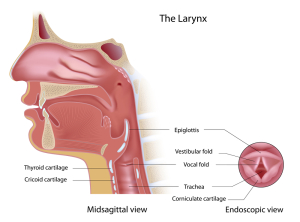Tracheitis or pseudomembranous croup occurs mostly in children and the onset is usually very acute. It can be caused by a number of bacteria such as Haemophilus influenzae, Staphylococcus aureus or group A beta hemolytic streptococcus.
Symptoms
There is a typical stridor (a high pitched sound with breathing) and a croupy cough (typical bark-like cough). This comes from a narrowing of the trachea because of acute swelling of the lining of the trachea.
There may also be a high fever, lots of pussy secretions and difficulties getting a breath. This is an emergency and warrants a call to 911(Emergency ambulance team) to get the child to the nearest hospital. If the breathing deteriorates, an emergency intubation or tracheotomy may have to be done.
Treatment
The pediatric ENT specialist will likely do a direct laryngoscopy for inspecting and diagnosing the condition. Alternatively a lateral X-ray of the trachea would show the subglottic narrowing due to a purulent membrane. Antibiotic coverage against the common bacteria mentioned above is initiated intravenously, such as cefuroxime. When the culture report becomes available this can be adjusted according to the sensitivity testing. Antibiotics are given for a prolonged course of 2 or 3 weeks. Delayed treatment leads to complications such as sepsis, retropharyngeal cellulitis or abscess formation, or bronchopneumonia. With prompt treatment none of these complications will occur.
References:
1. The Merck Manual: Bacterial Tracheitis (thanks to www.merckmanuals.com for this link)
2. TC Dixon et al. N Engl J Med 1999 Sep 9;341(11):815-826.
3. F Charatan BMJ 2000 Oct 21;321(7267):980.
4. The Merck Manual, 7th edition, by M. H. Beers et al., Whitehouse Station, N.J., 1999. Chapter 43.
5. JR Zunt and CM Marra Neurol Clinics Vol.17, No.4,1999: 675-689.
6. The Merck Manual, 7th edition, by M. H. Beers et al., Whitehouse Station, N.J., 1999. Chapter 162.
7. LE Chapman : Antivir Ther 1999; 4(4): 211-19.
8. HW Cho: Vaccine 1999 Jun 4; 17(20-21): 2569-2575.
9. DO Freedman et al. Med Clinics N. Amer. Vol.83, No 4 (July 1999): 865-883.
10. SP Fisher-Hoch et al. J Virol 2000 Aug; 74(15): 6777-6783.
11. Mandell: Principles and Practice of Infectious Diseases, 5th ed., © 2000 Churchill Livingstone, Inc.
12. Goldman: Cecil Textbook of Medicine, 21st ed., Copyright © 2000 W. B. Saunders Company
13. PE Sax: Infect DisClinics of N America Vol.15, No 2 (June 2001): 433-455.
14. David Heymann, MD, Editor: Control of Communicable Diseases Manual, 18th Edition, 2004, American Public Health Association.







